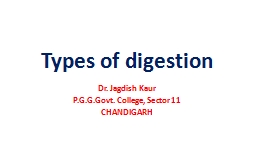

Kaur PGGGovt College Sector 11 CHANDIGARH Intracellular digestion Intracellular digestion Simple type of digestion which occurs inside the food vacuoles in the cytoplasm of the cell ID: 1010748
Download Presentation The PPT/PDF document "Types of digestion Dr. Jagdish" is the property of its rightful owner. Permission is granted to download and print the materials on this web site for personal, non-commercial use only, and to display it on your personal computer provided you do not modify the materials and that you retain all copyright notices contained in the materials. By downloading content from our website, you accept the terms of this agreement.
1. Types of digestionDr. Jagdish KaurP.G.G.Govt. College, Sector 11CHANDIGARH
2. Intracellular digestion
3. Intracellular digestion Simple type of digestion which occurs inside the food vacuoles in the cytoplasm of the cell. The nutrients get engulfed by cell through the process of endocytosis. When cell engulf large sized liquid nutrients then the food vesical is known as pinosome When cell engulf solid nutrients then the vacuoles are known as phagosome. After engulfing the food vacuoles get fused with the lysosome Lysosome have hydrolytic enzymes And low ph Digestion of the nutrients present inside the food vacuoles..
4. Intercellular digestionIt is a characteristic of higher animals. In this process the digestion of food takes place inside the lumen of the digestive track. It is more complex process then the intracellular digestion. In this process the digestive enzymes are secreted by the digestive glands present in the alimentary canal.In this large amount of nutrients get in short period of time effetely as compare to intercellular digestion.
5. Intercellular digestion involve 4 zones Ingressive zone: it involved uptake of food and mastication of food. this zone includes mouth, buccal cavity, vestibular cavity and mouth parts(teeth and tongue)..Progressive zone: it involve conduction and early digestion of food. This zone includes pharynx and oesophagus .Degressive zone: it involve the area of alimentary canal in which finally digestion and absorption of food takes place. This zone includes stomach and small intestine. The length of small intestine in both herbivores and carnivores are different Egressive zone: This zone act as temporarily storage of faeces and finally expel it out of the body. This region involve large intestine rectum and anus.
6.
7.
8. After digestion starch brake down in to small glucose molecules and fructose molecules.The fructose get absorb by the intestinal villi through the process of facilitated diffusion.Glucose and galactose molecules absorb by villi through the carrier translocase present on the plasma membrane of the villi.In this process Na+ ion and glucose molecule move inside the villi through symport method , the carrier translocase proteins have two receptors on their surface , In which Na+ ion move along the conc. Gradient at high speed due to which energy is generated which helps to move glucose molecule into the cell. when the conc. Of Na+ ion inc. inside the cell then it pump out into the blood vessel present within the villus in the presence of ATP.Finally the glucose enters into the blood capillary.Now, some undigested disaccharides like sucrose, maltose and lactose which are not absorbed by the villi enters into the large intestine .Bacterial flora present inside the large intestine helps in the digestion of that carbohydrates in the large intestine,Out of which only small amount is absorbed.
9. ASORPTION OF AMINO ACIDS
10. All the tripeptides , dipeptides and amino acids move into the cells of villi through the help of co-transporter. There as the dipeptides and trypeptides move inside the cell by the symport movement of peptide with H+ ion.Where as the amino acids move inside the cell by symport movement with Na+ ion. When di and trypeptide migrated inside the cell they brake down into small amino acids and get diffused into blood vessel . 1.fist transport system transport neutral amino acid in the cell of intestine . 2. second transport system transport acidic amino acids . 3. third transport system transport basic amino acids. 4. forth transport system transport di and trypeptides inside the intestinal villi cells
11. ASORPTION OF FATS
12. Bile salts emulsifier the fats due to which its surface area increases and digestion will takes place easily.After digestion of fats, fats get converted to fatty acid, monoglyceride and small fats molecules. Fatty acid and monoglycerides get easily absorbed by the intestinal cells.In case of small fats molecules they get fist absorbed by the intestinal cells. Inside cells it get converted to chylomicons and then it get enter into lymph vessels (lacteals).
13. HORMONAL CONTROL ON DIGESTION
14. Digestion involve 8 hormones Gastrin :stimulate stomach gastric glands to secret gastric juices.Secretin :stimulates the pancreas and liver to secret sodium bicarbonates.Pancreozymin :stimulates the pancreas to release pancreatic enzymes.CCK :stimulates gall bladder to contract and release bile.Enterogasterone :inhibits the secretion of gastric juices.Duocrinin: stimulates the brunner glands to release mucus.Enterokinin: stimulates intestinal glands to release intestinal juices.Villikinin: stimulates the villi to increases the surface area of adsorption.
15. MICROBIAL DIGESTION/ SYMBIOTIC DIGESTIONMan:- Large intestine-Escherichia coli & Streptococcus faecalis (colon)↓↓1.Protein content of chyle↓Amino acids2.Synthesise vitamins B2 & K3. Conversion of bile pigments into brown pigments
16. Contd.Ruminants/Cud chewing mammalsRuminant stomach-Rumen, Reticulum, Omasum ,AbomasumRumen symbiotic bacteria l cellulose ferment cellulose into short chain fatty acids ↓ 1. Acetic acid, butyric acid, propanoic acid ↓ Neutralised by sodium bicarbonate of saliva2.Formation of proteins frominorganic nitrogen carbon and ammonium salts3.Vitamin B complexTermites-TRICHONYMPHA-beta glucosidases ↓cellulose-----sugar
17. Contd.Lagomorphs ( Rabbit & hare)Food escapes action of gastric and intestinal enzymesBacteria secrete cellulases convertind cellulose into still nonabsorbable formSpecial kind of faeces at night but not droppedDirectly eaten from anus to pass through gut again for bacterial actionCoprophagy/ refection